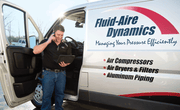Your air compressor’s location in your facility is critical to how it performs. But do you know exactly what you need to consider when determining where your compressor should go?
The location not only affects the compressor maintenance and its functioning… it can affect your facility’s efficiency and your employees’ productivity, too!
To help you find the perfect location for your unit, here are six key factors you need to consider before locking in its location.
Need Compressed Air System
Preventative Maintenance or Repair Services?
Call Us Today! 866.443.9926
1. Serviceability and Accessibility
Your air compressor should always be accessible for servicing. A rule of thumb is to place your compressor somewhere that allows a minimum of a three-foot radius around the unit. This allows doors on any side of your compressor to open fully, meaning different components can be changed during servicing.
Keep in mind, some components in your machine are larger, and may need more space in order for them to be easily removed, replaced, or repaired. Make sure you incorporate this distance into the placement of your air compressor.
That being said, there will be situations that require you place your air compressor in a less-than-ideal spot, which may mean you need to take additional steps to ensure your compressor is safe and accessible. For example, if you operate your unit on a mezzanine, you may need permanent stairs and support bars so servicing the compressor is safer and more convenient.
If your air compressor is in a more complex location, keep in mind that repairs, major component replacements, and even regular preventative maintenance is going to be more expensive due to the increase in time, and possibly the number of technicians, required to perform these tasks.
2. Air Circulation and Ambient Room Temperature
Air circulation and ambient room temperature are critical to keeping your system running with minimal downtime.
When installing your air compressor, make sure the initial air temperature in the room is cool. Air compressors generate their own heat, which means additional heat can cause your machine to shut down. The temperature in a compressor room should be 40 – 105℉. If your air compressor runs in a room toward either end of this temperature range, it will be working hard to keep up, causing the lubricants to break down quicker. This will require more frequent maintenance of your compressor.
Your system will also need proper air circulation and ventilation to prevent high-temperature shutdowns. Compressors exhaust warm air. So if your system is in an enclosed space, this can cause the room to get warmer and warmer, which will lead to your compressor shutting down on high temperature. You can prevent this by ducting your exhaust air to the outdoors. This allows your unit’s intake air to be much cooler, while reducing the likelihood of shutdown on high temperature.
*Quick Tip: You can have two ducts from the exhaust air; one leading outside for the summertime, and one leading into your facility for the wintertime. This saves you money on your heating bill, or if you don’t have heating, it heats your facility for free!*
3. Location of Power Distribution Center
Is there a power source near your compressor?
Believe it or not, the distance between your power and your system matters. The further away your power is, the more expensive it is to wire your compressor.
According to the national electric code guidelines, for every 100 feet between your equipment and the power distribution source, you have to increase your wire by one size. This causes the cost of powering your compressor to increase as the distance to the power source increases, so be sure to check the location of your power distribution center before settling on a location for your air compressor.
4. Ambient Air Cleanliness
If the ambient air around your air compressor is dirty, this could require more maintenance. If possible, place your air compressor someplace it has access to clean air. If you cannot avoid putting your compressor in an area with significant dust and dirt in the air, you could consider ducting in your intake air, but your intake filter should be sufficient enough to clean the air coming into your system.
5. Keeping the Area Around Your Compressor Clean
If your facility needs to stay clean at all times (like a food packaging facility), you should consider using a containment center around your air compressor. At some point in time, your compressor will experience inevitable oil leakages due to build up within the machine. A containment center will act as a gutter, capturing any oil and preventing it from spilling on your floors. The picture to the right shows a containment center on an Ingersoll Rand 200 HP rotary screw air compressor.
6. Employee Disruption – Noise and Vibration Levels
Are your employees near your air compressor? If so, you may want to reevaluate where your compressor is located. Some units can be noisy, which can lead to decreased productivity and unhappy employees.
If your unit is exceptionally loud, you can consider taking one of the following actions:
1. Move your compressor away from your employees
2. Get a quiet rotary screw air compressor
3. Build a room for your compressor with sound-absorbing walls
Commercial air compressor can also cause vibrations through floors. This can also lead to employee disruption for those working nearby. If your compressor is causing vibrations, you can use vibration dampeners to limit the transfer between the air compressor and the floor it is mounted to.
